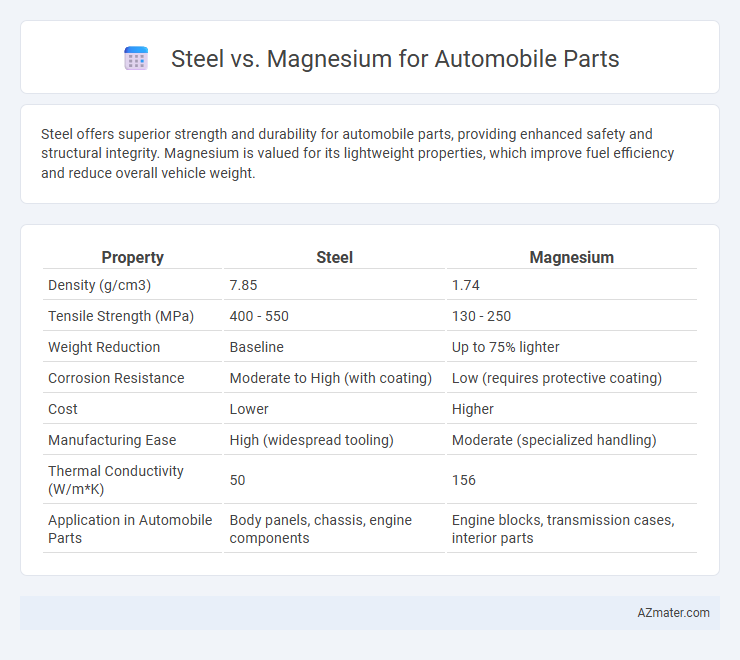Steel offers superior strength and durability for automobile parts, providing enhanced safety and structural integrity. Magnesium is valued for its lightweight properties, which improve fuel efficiency and reduce overall vehicle weight.
Table of Comparison
| Property | Steel | Magnesium |
|---|---|---|
| Density (g/cm3) | 7.85 | 1.74 |
| Tensile Strength (MPa) | 400 - 550 | 130 - 250 |
| Weight Reduction | Baseline | Up to 75% lighter |
| Corrosion Resistance | Moderate to High (with coating) | Low (requires protective coating) |
| Cost | Lower | Higher |
| Manufacturing Ease | High (widespread tooling) | Moderate (specialized handling) |
| Thermal Conductivity (W/m*K) | 50 | 156 |
| Application in Automobile Parts | Body panels, chassis, engine components | Engine blocks, transmission cases, interior parts |
Introduction: The Role of Material Selection in Automobiles
Material selection significantly influences automobile performance, safety, and efficiency, with steel and magnesium representing two pivotal choices. Steel offers high strength, durability, and cost-effectiveness, making it ideal for structural components, while magnesium stands out for its lightweight properties, enhancing fuel efficiency and reducing emissions. Balancing these materials involves optimizing weight reduction without compromising vehicle integrity and crashworthiness.
Steel Overview: Properties and Applications
Steel exhibits high tensile strength, excellent durability, and superior resistance to wear and impact, making it a preferred material for critical automobile parts like chassis, engine components, and body panels. Its ability to withstand heavy loads and harsh environmental conditions contributes to enhanced vehicle safety and longevity. Frequently alloyed with elements such as carbon, manganese, and chromium, steel combines strength with corrosion resistance, supporting diverse automotive applications.
Magnesium Overview: Properties and Applications
Magnesium is a lightweight metal with excellent strength-to-weight ratio, making it ideal for automotive parts aimed at reducing overall vehicle weight and improving fuel efficiency. It exhibits good vibration damping, corrosion resistance with proper coating, and ease of machinability, which supports complex, precision-engineered components such as engine blocks, transmission cases, and interior panels. The widespread application of magnesium alloys in automobile manufacturing contributes significantly to performance enhancement and emissions reduction in modern vehicles.
Strength and Durability Comparison
Steel offers superior strength and durability compared to magnesium, making it ideal for critical automobile parts requiring high load-bearing capacity. Magnesium, while significantly lighter, has lower tensile strength and is more prone to corrosion and fatigue over time. Advances in alloy technology and coatings can improve magnesium's durability, but steel remains the preferred choice for components demanding maximum structural integrity.
Weight and Fuel Efficiency Implications
Steel offers high strength and durability at a higher weight, increasing vehicle mass and potentially reducing fuel efficiency. Magnesium, significantly lighter than steel--up to 35% lighter than aluminum and 75% lighter than steel--reduces overall vehicle weight, leading to improved fuel economy and lower CO2 emissions. Automakers favor magnesium for weight-sensitive parts to enhance fuel efficiency and comply with stringent environmental regulations.
Cost Analysis: Production and Lifecycle Expenses
Steel offers lower initial production costs due to its widespread availability and established manufacturing processes, making it a cost-effective choice for automobile parts. Magnesium, despite higher raw material and processing expenses, provides significant lifecycle savings through weight reduction, which improves fuel efficiency and reduces emissions. Evaluating total cost of ownership, magnesium parts can deliver long-term economic benefits in fuel savings and vehicle performance despite their upfront investment.
Corrosion Resistance and Environmental Factors
Magnesium alloys exhibit superior corrosion resistance compared to traditional steel when coated or treated properly, making them favorable for lightweight automobile parts exposed to moisture and harsh environments. Steel, while inherently prone to rust due to its iron content, benefits from advanced galvanization and alloying techniques that enhance its durability against corrosion. From an environmental perspective, magnesium's lower density reduces vehicle weight, improving fuel efficiency and lowering CO2 emissions, whereas steel's widespread recyclability supports sustainable manufacturing but typically results in heavier vehicle components.
Manufacturability and Design Flexibility
Steel offers superior manufacturability for automobile parts due to its well-established production processes, high strength, and cost-effectiveness, enabling mass production with consistent quality. Magnesium provides enhanced design flexibility with its lightweight properties and excellent castability, allowing complex shapes and intricate geometries that reduce vehicle weight and improve fuel efficiency. Balancing steel's durability and low cost against magnesium's design adaptability and weight savings is critical for optimizing automotive component performance.
Safety Considerations: Crashworthiness and Fire Risk
Steel offers superior crashworthiness due to its high tensile strength and energy absorption capabilities, making it a preferred choice for critical automobile parts in collision scenarios. Magnesium, while lighter and beneficial for fuel efficiency, presents increased fire risk because of its flammability and propensity to ignite at high temperatures during crashes. Manufacturers often balance these safety considerations by integrating steel in impact zones and magnesium in non-structural areas to optimize overall vehicle safety and performance.
Future Trends: Innovations in Automobile Material Usage
Future trends in automobile material usage highlight magnesium's rising prominence due to its exceptional lightweight properties and strength-to-weight ratio, contributing to enhanced fuel efficiency and reduced emissions. Steel remains essential for its durability, cost-effectiveness, and recyclability, driving innovations in advanced high-strength steels and tailored alloys to maintain vehicle safety and performance. The automotive industry increasingly adopts hybrid material designs, combining steel and magnesium in strategic parts to optimize weight reduction without compromising structural integrity.

Infographic: Steel vs Magnesium for Automobile Part
 azmater.com
azmater.com